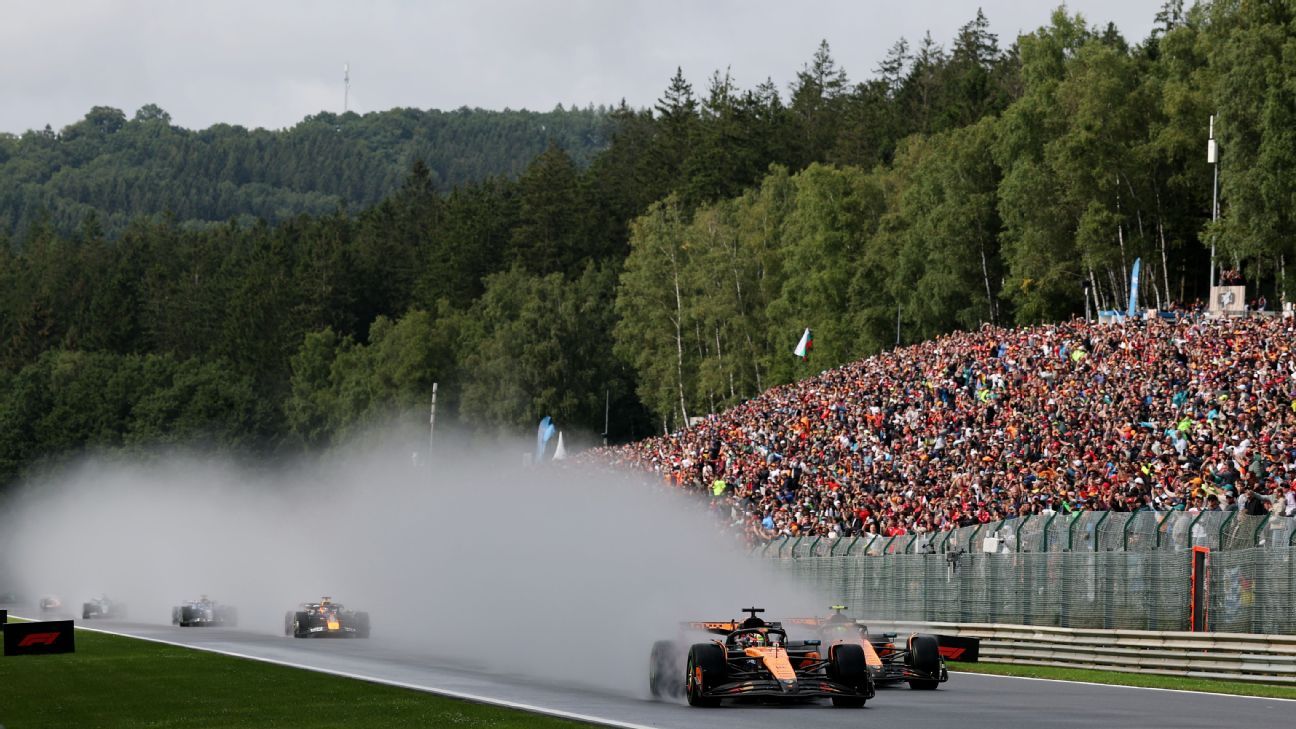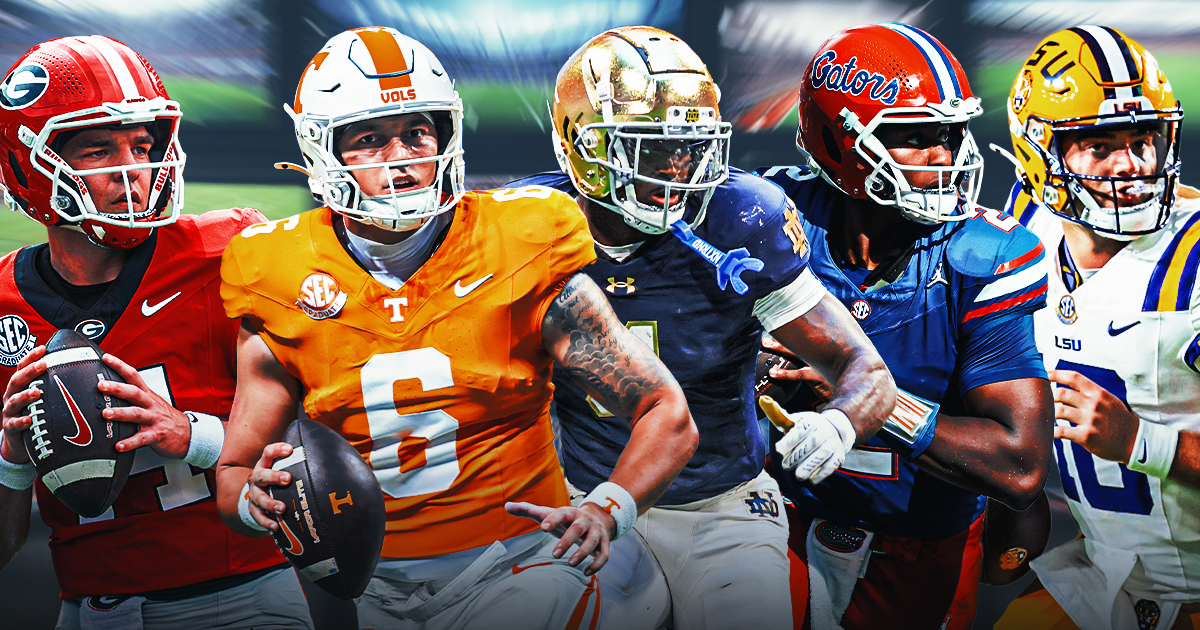
SPA-FRANCORCHAMPS, Belgium — As rain fell over one of motor racing’s most revered circuits midway through Sunday afternoon, the greatest racing drivers in the world sat in their team garages waiting for the all clear to go racing.
Rain had started falling almost as soon as drivers had left the pit lane for the customary half hour on the grid before the race. Before long, it was hammering down; the Belgian national anthem was sung in heavy rain, although it appeared to be easing off by the time the scheduled 3 p.m. local start time approached.
Excessive levels of standing water and the fact that it was still raining, albeit at a lessening tempo, saw the formation lap of Formula 1’s Belgian Grand Prix take place behind the safety car. Even at a significantly reduced speed, the feedback from the drivers was similar: visibility in the heavy spray was terrible. Pole sitter Lando Norris told McLaren he could barely see anything and that he could only imagine how bad it was for cars further back in the pack.
The FIA had heard enough. At the end of that lap, the safety car led the pack back into the pits. The governing body said there was a lull in the weather on the horizon and it would delay the start until then.
That explanation did not satisfy everyone. When asked later when the race should have started, reigning world champion Max Verstappen made his view clear.
“Three o’clock … straight away,” he said. “It was not even raining, and of course between Turn 1 and 5 there was quite a bit of water, but if you do two or three laps behind the safety car, then it would have been a lot more clear, and the rest of the track was anyway ready to go.”
Verstappen won a wet-weather classic in Brazil last year and is perhaps the grid’s premier talent in those conditions — it would be easy to suggest the Dutchman’s best chance of beating the McLarens was a race in that weather — but giving the underwhelming contest that eventually followed, it was also easy to agree with his assessment.
Effectively 90 minutes went by between the moment the race should have started and when Norris finally led a rolling start for the first racing lap of the afternoon. In the intervening period, drivers sat looking bored in their garages, as engineers and producers looked diligently at weather radars about the cloud movement around the circuit. Hardly scintillating stuff, especially when many felt the conditions were good enough to go racing.
It was hard to escape the feeling that F1 had opted out of a potential classic contest by waiting so long to start, especially given where the race was taking place. The region’s volatile weather has transformed many of Spa’s races, such as the crash-strewn 1998 contest — which might be the most dramatic wet-weather contest of all time — into instant classics. By the time the delay had ended on Sunday, the chance of a repeat seemed to have vanished.
The improvement in conditions when racing did start was rapid. By the end of the 11th of the allotted 44 laps, Lewis Hamilton made the first stop to switch from the intermediate wet tire to slicks. Everyone else followed suit within the next three laps. By the time the conditions had stabilized, drama was minimal; Hamilton entertained early on with a surge through the field, but even that was short lived.
“It’s a bit of a shame. Of course I knew that they would be a bit more cautious after Silverstone, but this also didn’t make sense,” Verstappen said on Sunday night. “Then it’s better to say, ‘You know what, let’s wait until it’s completely dry,’ and then we just start on slicks, because this is not really wet-weather racing for me.”
The Silverstone reference was a good example of the challenge facing the decision makers when the rain falls. Earlier this month, the FIA appeared to bring the safety car in too early as the rain worsened at the British Grand Prix. Almost as soon as the race had resumed on lap 17, Isack Hadjar slammed into the back of fellow rookie Kimi Antonelli, whose Mercedes was unsighted in the worsening spray.
Hamilton also referenced that moment when asked about the delay, and suggested that drivers, who convene every Friday of a race week for a briefing with the race director, had brought up that decision in discussing the prospect of rain for Sunday’s race.
“I think it was just a reaction to Silverstone …,” he said. “We sat down and spoke about it, and the drivers said in the last race we shouldn’t have restarted. So I think they just focused on visibility. As soon as someone said, up ahead [that] visibility was really bad — which, it wasn’t great … it wasn’t as bad as the last race — and I think they just waited just to be sure.
“I think they still did a good job. Of course, we did miss some of the extreme wet racing, which I think would have been nice. But for some reason, the spray here is really, well, this year at least, it’s like going through fog. I don’t know what we’re going to do to try and fix it.”
In a different interview to Sky Sports, Verstappen said: “Of course we spoke about it after Silverstone, to be a little more cautious because there was quite a lot of water there, but this for me it was the other extreme. It just ruined a nice classic wet race as well.”
The legend of Spa also muddied the decision on Saturday afternoon, as did the radar confirmation that a clear — and long-lasting — period of dry weather was coming.
Verstappen had referenced “between Turn 1 and 5” as being particularly wet, and that stretch is perhaps the most legendary part of the track, which starts with a slow hairpin, La Source, followed by a downhill section leading to the legendary Eau Rouge, which slingshots drivers up and then over the crest of a hill at Raidillon and onto the Kemmel Straight. It might be the most revered stretch of tarmac on the Formula 1 calendar, even if modern day cars have taken away some of the corner’s mythology. It remains one of the fastest parts of any race track in the world. That, coupled with the prospect of heavy spray and Raidillon’s blindspot, surely presented too much of a risk.
Mercedes driver George Russell — head of the Grand Prix Drivers’ Association, effectively the F1 drivers’ union, which has regularly pushed safety as a key issue — referenced those sections of the Spa track in the defense of the delay.
“I mean, as a racer, you always want to get going. You love driving in the rain,” Russell said. “But the fact is, when you’re doing over 200 miles an hour out of Eau Rouge, you literally cannot see anything, you may as well have a blindfold on. It isn’t racing, it’s just stupidity.
“So, I think considering it was clearly going to be dry from four o’clock onwards, I think I made the right call.”
Fittingly in a race where a call ultimately rooted in safety dominated the headlines, a poignant reminder of the stakes came courtesy of the world feed broadcast.
During the event, cameras panned to the mother of Anthoine Hubert, who was killed during the Formula 2 race at Spa-Francorchamps in 2019. Hubert had run off track at the blind crest of the hill at the Eau Rouge section and was T-boned by another car as his bounced into the middle of the road. His crash had happened in a dry race.
Nathalie Hubert was in the Alpine garage watching Sunday’s race with the mother of Pierre Gasly, who starts every race week at Spa laying flowers at the point of the race track his friend hit the tire barrier. Gasly has also annually led the paddock-wide Run for Anthoine on Thursday, which has become a regular fixture in the years since his accident.
1:44
Piastri leads Belgian GP after rolling start
Oscar Piastri leads the Belgian Grand Prix after a rolling start due to heavy rain.
The prospect of heavy rain and Spa, especially that part of the circuit, could understandably lead to jitters. In 2023, Dutch teenager Dilano van’t Hoff was killed in a Formula Regional European Championship race a little further down the road from the site of Hubert’s accident, in a race that took place in heavy rain. Trackside footage showed the incident unfolding in a cloud of spray as a pack of cars roared through at racing speed. Like Hubert, Van’t Hoff’s car was struck side-on as it bounced back into the race track.
With the biggest potential for jeopardy taken out of the race, McLaren’s Oscar Piastri and Norris comfortably claimed a one-two finish. McLaren team principal Andrea Stella offered perhaps the most reasonable summary of the delay in his own media session on Sunday night.
“I think today the race was managed in a very wise way by the FIA, because we knew that there was a lot of rain coming, and I think in a circuit like this, if you make the calls late, it may be too late, and the outcome could be a difficult outcome,” Stella said. “So I think being on the forefoot is the right approach, and delaying the race allowed us to race in wet conditions, and then we went into dry, but in fairness, we are in Spa, we didn’t even know how long the dry race would have been, and we knew that there could have been wet conditions again at the end.
“So I think from our position as a team, we always praise the work of the FIA when this is deserved, and I think this is one of the cases in which this should be praised. Because I understand that it would be quite entertaining to see cars going in wet conditions, but we all should be wary that the average speed in Spa is so high that the cars just displace such a large amount of water that it’s just impossible to see.
“We have seen already in Silverstone that a car drove into the gearbox of another car, because it was impossible to see it, and it was slower and there was less water [than there would have been at Spa]. So we don’t want to see the same in Spa, so well done by the FIA.”
#Spa #stakes #high #risk #safety #wetweather #excitement






